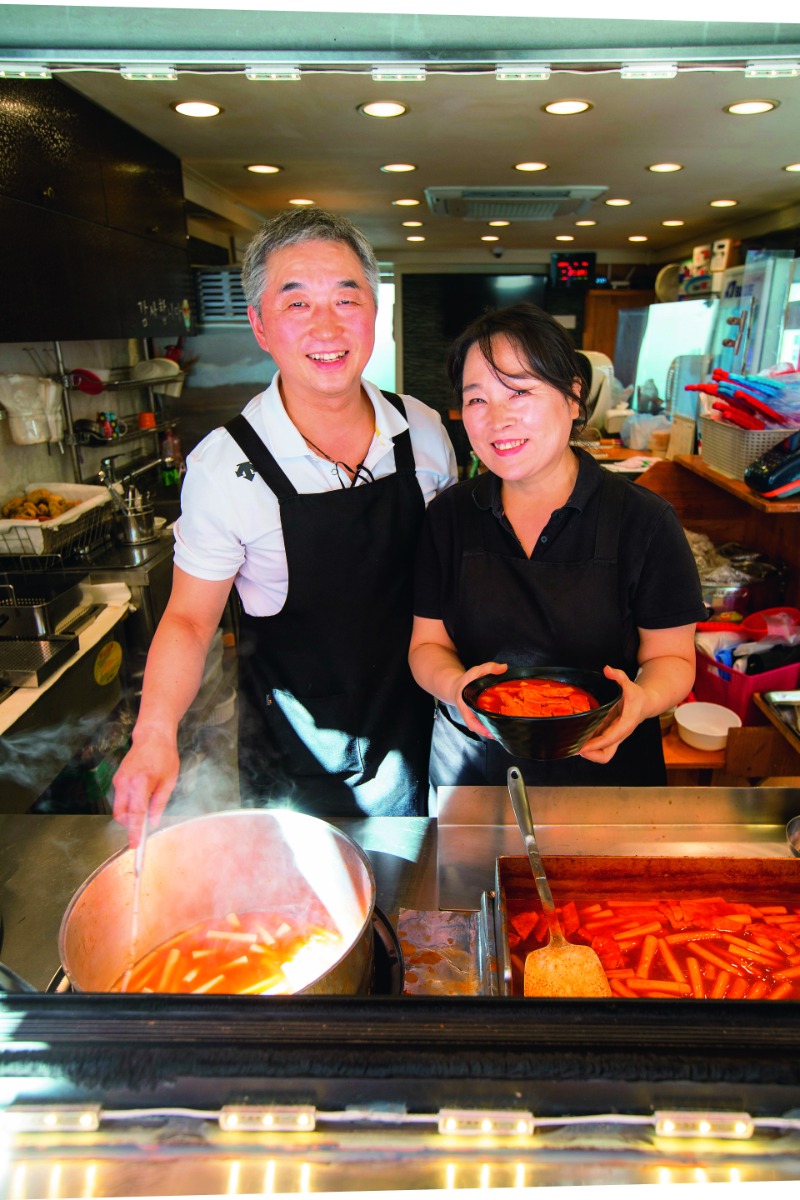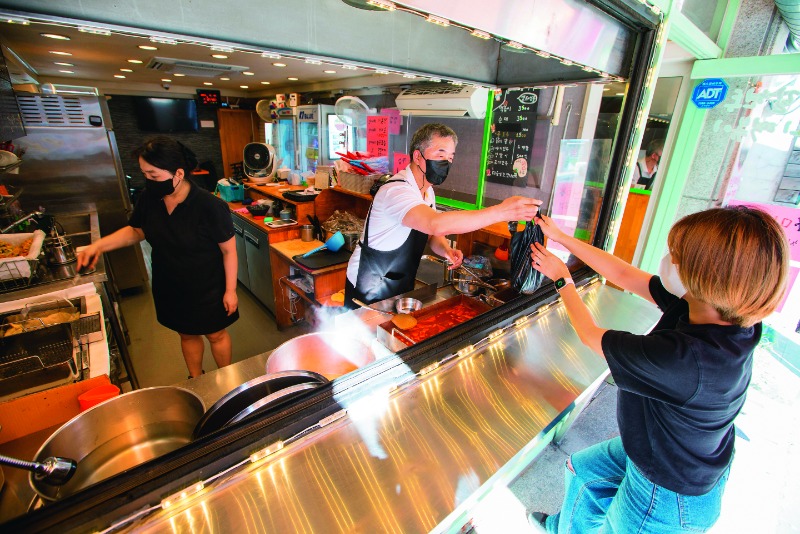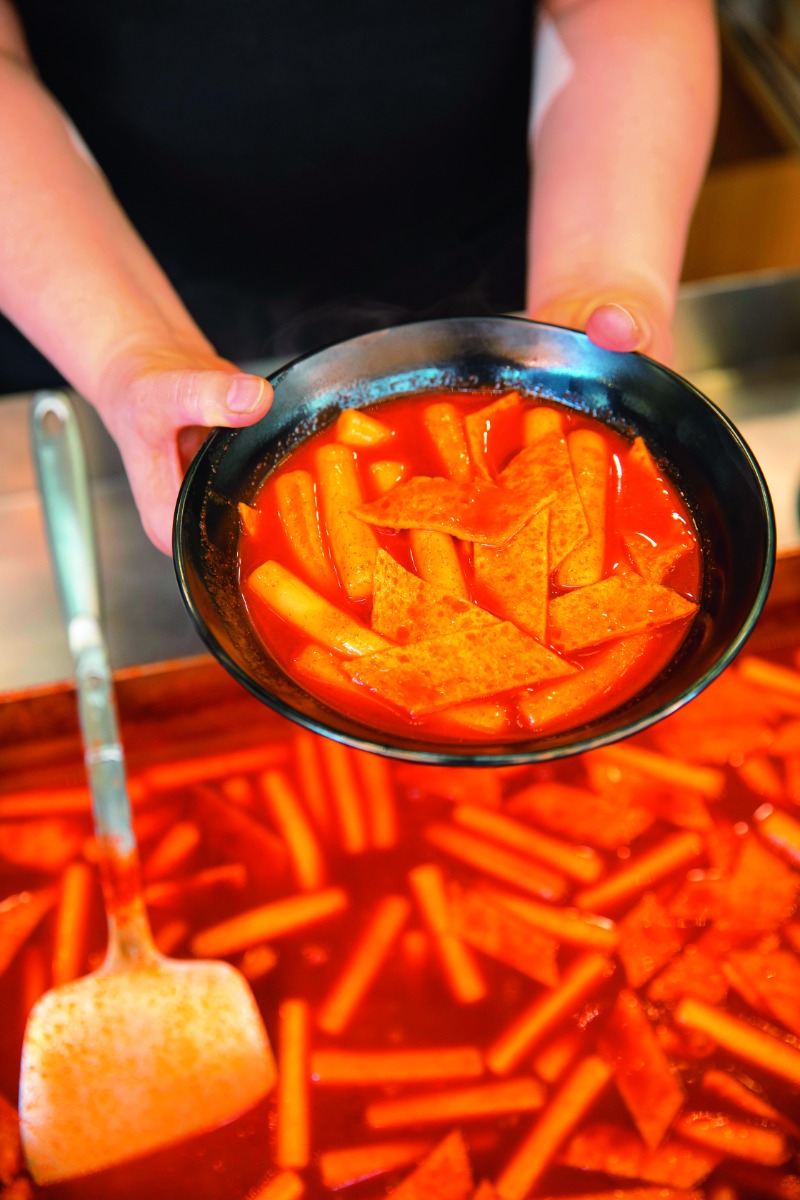Tteokbokki, simply put, is the soul food of Korean cuisine. Slight variations may reflect tastes of a certain region or era, but this humble dish never wavers as a go-to snack. At Galhyeon Market Grandma Tteokbokki, her acclaimed shop in northwestern Seoul, Kim Jin-sook carries on a 40-year tradition, bringing the signature taste of a secret family recipe to loyal customers day after day.
To be Korean is to have at least one formative memory that involves tteokbokki. The mouth-watering smell of rice cakes smothered in a piquant sauce always seemed to lace the alleyway between home and school;this is a siren call not easily forgotten, no matter how many years have passed.
The first written record of tteokbokki appeared in Siui jeonseo (“Compendium of Proper Cookery”), a Joseon Dynasty cookbook compiled in the late 19th century. It described a “royal court dish made by stir-frying plain white rice cakes with beef sirloin, sesame oil, soy sauce, scallion and mushrooms.”
The most common tteokbokki today is made with gochujang (red pepper paste), not soy sauce. Street food vendor Ma Bok-rim (1920-2011) is known as the godmother of this version, transforming a food originally identified with royalty and high-quality ingredients into an inexpensive favorite of the masses.
In 1953, shortly after the Korean War ended, Ma visited a new Chinese restaurant with some guests. In observance of the opening, each table received celebratory tteok (rice cake). After Ma accidentally dropped a piece of the tteok in her bowl of jjajangmyeon (noodles with black bean sauce), she found the result to be shockingly delicious. At home, she experimented with gochujang, which cost less than Chinese black bean paste, and soon opened a shop in Sindang-dong, then on the eastern outskirts of Seoul. Thus, today’s standard tteokbokki was born – and so was a famed tteokbokki hotspot.
By 1970, tteokbokki was firmly established as a popular snack among Koreans. At the time, snack stands that catered to tweens and teens were all the rage, with some even hiring DJs who would play customers’ requests. Listening to one’s favorite song on the way home from school while sharing tteokbokki with friends became a fond pastime of an entire generation of youth.
In the 1980s, Kim Jin-sook’s mother-in-law, Jin Yang-geun, then in her m id- 4 0s, bega n sel l i ng t teokbok k i from a market stall in the Galhyeondong neig hborhood of Seou l’s Eun- pyeong District. The stall didn’t even have a sign, but three girls’ high schools nearby ensured a robust lunch crowd.
FAMILY’S LIVELIHOOD
Kim and other family members began to work part time at the stall when Jin’s hip surgery meant she could no longer work. Eventually, Kim decided to ladle tteokbokki full time. She admits now that she didn’t realize what the commitment would entail.
A large-scale urban renewal program led to the demolition of the Galhyeon Market in 2015. But Kim and her husband, Kim Wan-yong, kept their tteokbokki business alive, opening a new shop in the same spot as the former stall. The name of the shop: “Galhyeon Market Grandma Tteokbokki.”
“ She was a l ready over 80 at the time, but my mother-in-law never really liked being called ‘Grandma,’” Kim laughs. “The menu is exactly the way it was at her stall in the market: tteokbokki, sundae (blood sausage), two types of dumplings, boiled eggs and seaweed rolls.”
Jin Yang-geun’s basic tteokbok ki recipe is still used, but the proportions of the sauce have changed slightly to shave the edge off a tiny bit and soften the flavor all around. The result is less sweet, less salty and less spicy. Kim puts a lot of effort into selecting her ingredients, always keeping health and sanitation in mind. Her unwavering consistency and devotion pay annual dividends: the shop is a perennial on any list of Seoul’s best tteokbokki spots.

Kim Jin-sook and her husband, Kim Wan-yong, owners of Galhyeon Market Grandma’s Tteokbokki in the Galhyeon neighborhood of Seoul’s Enpyeong District, spend their day on the exact spot where Mr. Kim’s mother opened a food stall to serve the bite-size rice cakes smothered in a savory sauce some 40 years ago.
PERENNIAL HOTSPOT

Galhyeon Market Grandma’s Tteokbokki is particularly beloved by diehard tteokbokki fans for the long-term consistency of the Kims’ signature flavor. The sauce they use was invented in the 1980s by Ms. Kim’s mother-in-law. The recipe is a carefully guarded secret.
Kim’s husband arrives at the shop at 7 a.m. In the first hour, he sets up all the necessary utensils, which were cleaned the night before. Then he puts the water on as he steams the sundae, boils the eggs and makes all the other necessary preparations.
“The wheat flour tteok for tteokbokki is all clumped together, and separating those pieces, one at a time – that’s hard work,” Kim explains. “You can get tteok that comes separate, but it doesn’t taste as good. Separating by hand means another step for us, but a tastier product for our customers. One box of tteok comes to 324 separate pieces, and we sell about 10 boxes a day.”
Once the two hours of prep are over and 9 o’clock rolls around, the shop opens for business. Kim comes to work around 10 a.m. Husband and wife don’t follow any strict division of labor, as both have to be able to do everything in case the other is away.
The most important step in the recipe is the “initial boil.” Each piece of tteok, separated by hand, is briefly blanched in boiling water before being deposited into the actual cooking pan. If this step isn’t completed properly, the tteok can become mushy and formless, or tough. The key is being able to sense the state of that day’s fresh tteok, which is invariably slightly different from the days before and after, and adjusting the heat and timing accordingly.
“People often joke about quitting their office job and setting up a tteokbokki stand, but this line of work actually requires a lot more care and attention than they realize,” Kim says.
The secret to t teokbokki that is tasty enough to draw an endless line of customers is in the sauce – specifically, the ratio of ingredients, the level of heat and the exact cooking time. It doesn’t matter how good the ingredients are if the ratio, temperature or timing isn’t precise. Jin Yang-geun created the process and the sauce with 10 ingredients.All of this is now the family’s precious trade secret.
After a long-delayed price increase, one serving of tteokbokki is 3,500 won these days. “When the minimum wage goes up each year, that’s reflected in an uptick in the price of every ingredient, which means we’re forced to raise our prices a bit, too,” Kim says. “But at the same time, because most people eat tteokbokki as a snack rather than a proper meal, it’s not easy to pull off. We worried and debated about it constantly for six and a half years before we finally raised our prices by 500 won in April of this year.”
Kim calls a single serving of tteokbokki a “rubber band.” This is because even though one serving is supposed to be 17 or 18 pieces of tteok mixed with fish cake, she always ends up scooping on a little extra if the customer is a student or a laborer.
At less than 10 pyeong (33 sq. meters), the shop is quite cozy, though it’s been a full year since customers have eaten inside due to COVID-19. In one corner sits an electric rice cooker and an induction stove top; this is where the couple makes breakfast and lunch for themselves. The shop closes around 8 p.m. and by the time the couple cleans everything and returns home, it’s usually 10 p.m.
“We take one day off a week, on Mondays. In all the years since we opened shop, we’ve ta ken a total of three days off that weren’t Mondays. One was the day after I had surgery, one was the day our son entered his military service, and one was the day he finished it,” Kim explains.
The secret to tteokbokki that is tasty enough to draw an endless line of customers is in the sauce – specifically, the ratio of ingredients, the level of heat and the exact cooking time.

Made by blanching plain white tteok in boiling water and then combining it with various vegetables and fish cake in a gochujang sauce, tteokbokki is nothing more or less than “soul food” for Koreans of all ages and backgrounds.
PROMISE TO CUSTOMERS
“There are times we want to take more time off, of course, but these hours are a promise we’ve made to our customers. And it’s not just folks from the neighborhood who come, you see. We get people from all over the country, going out of their way to come eat our tteokbokki, and I would hate for them to be disappointed. Besides, our days off aren’t that different anyway. I handle the house chores that need handling and go to the hospital to get treated for my carpal tunnel syndrome. An occupational disease.”
Most of their customers are warm and friendly. Some have been known to drop by with cold drinks when the weather gets hot, for the Kims to have as they work, and others even bring them extra vegetables from their garden.
“There are people who remember my mother-in-law from years ago and bring their children by for a visit, or even come by in a group after an elementar y school reunion. Those are customers who come to feast on memories rather than tteokbokki. Seeing customers like that reminds me of warmth, kindness and ways of spreading goodwill. I’ll find myself thinking, this is what living in the world is really about.”
That’s what makes Kim feel so wistful about the fact that the shop will eventually disappear one day. The plan is to keep the place going for another 10 years, then shutter it for good. She doesn’t want to pass down such a challenging business to her two children. Though, of course, that may probably change in case, after trying other lines of work following their own dreams, either of them finally decides to carry on their family business of filling bellies, creating memories and warming hearts.